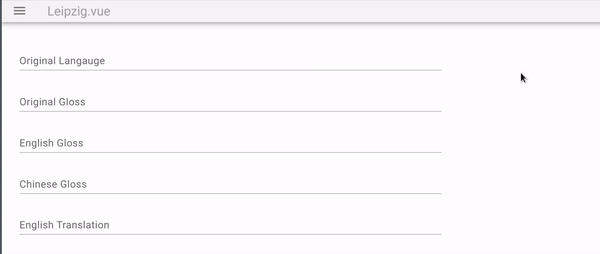Recreating Leipizig.js with Vue for Interlinear Glossing
I noticed Leipzig.js from George Moroz’s GitHub activity (he starred bdchauvette/leipzig.js a few months ago). This JS library is fantastic, and at the moment I saw it, I came up with an idea of building a web app facilitating interlinear glossing.
During Chinese New Year, I finally started on the project. I thought it would be easy since I had some experience with Vue.js before1, but it turned out that leipzig.js wasn’t designed to work with Vue.
Dynamic Input Interface
What I had in mind was a web app that, while the user is typing, the rendered glosses get showed synchronously in another panel. Vue’s conventional way of doing this is by creating a two-way data binding (v-model) to capture the user’s input and dynamically render the HTML content based on the inputted data. This conflicts with leipzig.js since it only provides a high level function (Leipzig()) to modify existing DOM elements to construct the glosses. Calling Leipzig() multiple times (without erasing the already rendered HTML) would break the DOM elements, which makes the function hard to work together with Vue2.
After multiple failures of making Leipzig() to work with Vue, I decided to abandoned leipzig.js and recreate its functionality with Vue. This wasn’t as terrifying as it may seem, since I can use leipzig.js’s CSS rules directly to help me align the rendered DOM elements by Vue. What I had to do was making sure that Vue generates the exact same HTML structure as leipzig.js’s rendered glosses. The resulting input interface is shown in the GIF below.

The source code of this vue component can be found in Leipzig.vue.
Other Parts of the App
There are several advantages of adopting Vue instead of using traditional JS approaches to build the app. Since what I wanted to build was an app that can also store, manage, and export glosses for the user, I needed a framework to help me manage this complexity (e.g., Vuex), and Vue provides a good and manageable way to build a complex web app. After learning Vuex and experiencing some failures in my previous Vue project (due to increasing complexity as the app grows larger), I’m pretty sure that I could build a better app with less complexity this time. But just when I was moving forward to other parts of the app, I was stuck by other work to do, so I’m currently not developing this app. Currently, the only usable part of this app is its dynamic input interface for previewing glosses.
In 2019 summer, I learned Vue.js on The Net Ninja’s YouTube channel and built a markdown editor for fun. ↩︎
Though it is possible to create a dynamic input experience with
leipizig.jswith a more traditional JS approach. You can read the source code of this Live demo of Leipzig.js to find out how it works! ↩︎